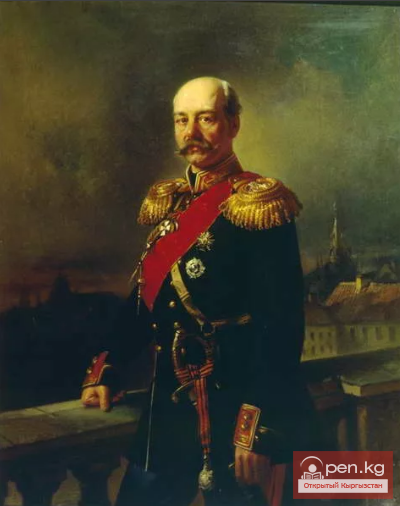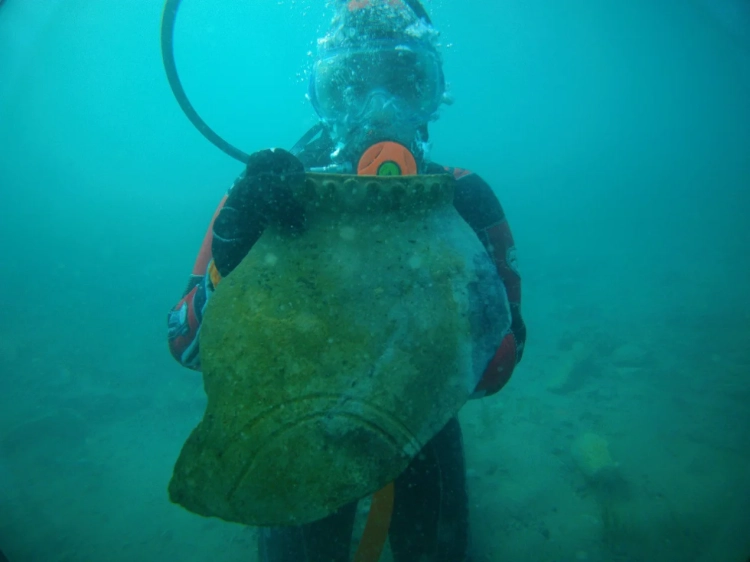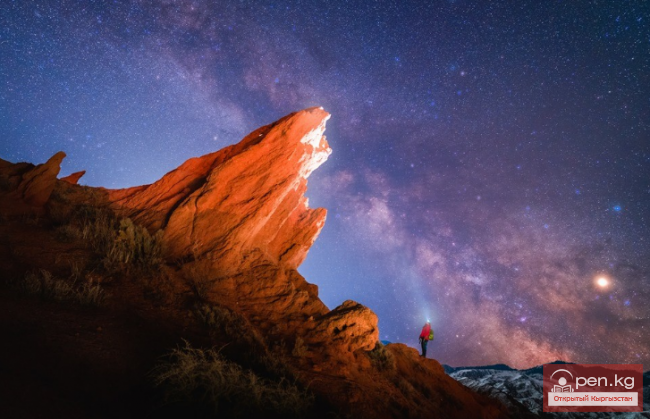
The Unfulfilled Dreams of Governor Kaufman
The Turkestan Governor-General K. P. von Kaufman did not forget the letters he received from Pyotr Petrovich Semenov, who, after several years following his journey to Issyk-Kul, had become a recognized scholar and effectively the head of the Russian Geographical Society. P. P. Semenov pointed out the underwater finds of the Kyrgyz at Issyk-Kul, noting their undeniable scientific value and urging the search for antiquities to be concentrated in a museum that should definitely be opened in Tashkent.
In the office of the Turkestan Governor-General, there was a note written in 1856 at the request of Chokan Valikhanov by merchant Isaev, who had frequently traveled with caravans across Issyk-Kul to Eastern Turkestan in the 1820s. The merchant mentioned some underwater ruins in the Tyup Bay, to the right of the river's mouth into the lake.
“The visible buildings in the water are made of stone,” the note reads, “but one must ride on horseback for about two hundred sazhens. The locals say that there used to be a great city here, and a flood occurred, and that there was no lake here before.” Of course, Kyrgyz legends about the formation of the lake were also mentioned. Kaufman paid little attention to them. Another matter was the letter from the enlightened statesman P. P. Semenov! Moreover, the military governor of the Semirechye region, G. A. Kolpakovsky, insisted on the same and sent ancient items as confirmation, most of which were from underwater!
While on official business, G. A. Kolpakovsky visited Issyk-Kul in 1869. It was said that he forced the first Russian settlers and Cossacks to plant trees along the road, and those who disobeyed were immediately punished with whips; the peasants endured, grumbled, but carefully planted the required number of saplings, which turned the road along the northern shore of Issyk-Kul into a continuous green tunnel within a few years.
Upon returning from his trip to the regional center, the city of Verny, Kolpakovsky sent a note to Tashkent, which was read at a meeting of the founding members of the Central Asian Scientific Society in November 1869 (even before its official opening). The note spoke of ancient “objects found in the southeastern part of Issyk-Kul, proving the existence of a city in this place in ancient times.” At the same time, Kolpakovsky sent a brief report to the "Proceedings of the Russian Geographical Society" describing a vast underwater area he had seen, which, he wrote, seemed to be specially paved with bricks, fragments of pottery, and bones.
He also saw a stone statue underwater.
Kolpakovsky was an initiative official and did not limit himself to mere official zeal. His interests extended to the scientific exploration of the region. He visited Issyk-Kul annually, constantly inquiring about its antiquities, collecting randomly found artifacts. On November 3, 1871, the military governor sent another report to K. P. Kaufman stating: “During my last trip to the southern part of the Semirechye region, I acquired two archaeological items and two silver coins found on the shore of Issyk-Kul.”
These were: a large copper bowl discovered by the Kyrgyz at the mouth of the Sary-Bulak River, where it flows into the lake (on the northern shore), and a copper bowl with Arabic script found at the mouth of the Koysu River on the southern shore and gifted to the general by the Sary-Bulak manap Umetaly. The translator at the Turkestan Governor-General's office, an expert on local customs and dialects, Sh. M. Ibragimov, translated the Arabic inscription on the bowl: “Spring days bring us happiness. O water-bearer! Give me, life-giving moisture... A drink resembling a rose gives beauty to the vessel, just as dew revives the tulip. Consider as life the time that gives enjoyment to mortals.”
The bowls undoubtedly belonged to the long-gone Middle Ages and were likely made during the Karakhanid period, which ruled over the territory of Kyrgyzstan in the 10th to 12th centuries from the capital Balasagun, the ruins of which are currently being excavated by our archaeologists near the city of Tokmak, located 60 km east of Bishkek.
G. A. Kolpakovsky suggested to K. P. Kaufman to organize scientific research at Issyk-Kul, assigning it to the young naturalist A. P. Fedchenko. “In general, the mystery of Issyk-Kul is increasing day by day and compels me,” he wrote, “to once again express the need for research. The difficulties regarding the arrangement of the vessel can be resolved if possible. While waiting for Mr. Fedchenko at Issyk-Kul, I ordered the construction of a small sailing vessel, which is already nearing completion. In addition, for this same purpose, a private individual has arranged an eight-oared boat. Then, for the completeness of the project, we lack a diving apparatus, the acquisition of which through private means is more than doubtful.”
K. P. Kaufman generally liked G. A. Kolpakovsky's proposal, and on November 10, he affixed a resolution to his letter stating: “The items: the cauldron or large bowl and the small bowl should be kept here for the future museum... As for the diving apparatus (suit), it can only be ordered with a master, and therefore I ask His Majesty's suite, General-Major Zverev, the builder of Kronstadt, if he could assign someone to gather information on who will build the most durable device and under what conditions it would be possible to find a hunter willing to come here and engage in research.”
Having become somewhat interested in the finds and realizing the possibility of becoming a patron of the sciences in the region, K. P. Kaufman eagerly took up the acquisition of the underwater apparatus and the search for a diver.

At one time, while reviewing documents from the archive of the Turkestan Governor-General's office, we discovered a case titled “On Archaeological Finds at Lake Issyk-Kul, Acquisition of a Diving Apparatus and Hiring Divers for Underwater Research at Issyk-Kul. Description of the Suit,” dated November 15, 1871 — October 20, 1873. It turned out that more than a hundred years ago, an attempt was made at the first underwater archaeological research of ancient monuments at the bottom of Issyk-Kul — settlements and fortresses. How successful this was will be seen below.
After persistent proposals from G. A. Kolpakovsky and preliminary official notifications, K. P. Kaufman wrote to the builder of the Kronstadt fortress, Konstantin Yakovlevich Zverev, requesting help in organizing the research of the underwater mysteries of Issyk-Kul.
“Lake Issyk-Kul,” he wrote, “located within the Semirechye region, represents a very rich material for archaeological research. The ancient items found at the bottom of this lake and the rivers flowing into it at different times testify that the area where Lake Issyk-Kul is located was in completely different conditions than it is now... Unfortunately, archaeological finds are still so poor, as they are obtained accidentally by the uninterested nomadic population, and they are so diverse that they do not yet provide data for any conclusions...” And the Turkestan Governor-General asks the Kronstadt specialists to assist in acquiring the necessary diving suit and attracting diving specialists. “In this case,” Kaufman writes, “it is primarily necessary to take into account that since the purpose of inviting such a master is mainly archaeological research, a developed, capable, strong, and sober person is needed.”
Since there were no domestic diving devices and suits that met the special conditions and archaeological tasks, Zverev, having received preliminary descriptions of several advertising samples from the Paris exhibition, asked whether they should be purchased abroad, where “significant improvements have been made in the design of diving suits,” but all of them cost a considerable amount of money. For instance, one of the proposed improved French diving devices with a regulated air reservoir, called “artificial lungs,” which was awarded a Gold Medal at the World Paris Exhibition of 1867, cost 1625 rubles — a huge sum for those times!
A detailed description of the suit with drawings was sent to Tashkent. But..., as often happens in history, in the end, there was no money specifically for the purchase of the apparatus and the invitation of a diver. The sailing vessel unexpectedly sank, A. P. Fedchenko did not arrive at the appointed time. And the good intentions remained unfulfilled. Only the archival case testifies to the unfulfilled dreams of the governor.
Chigu — The Mecca of Researchers of the Pre-Issyk-Kul Region











































